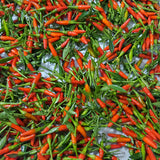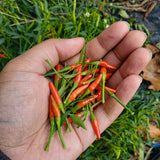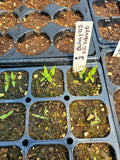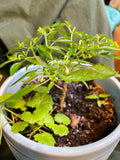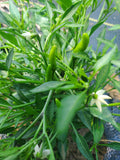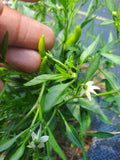Siling Labuyo Pepper
Capsicum frutescens
This small, spicy, bright red pepper, that is also eaten semi-ripe or green, is often used to make sawsawan—dipping sauces made with different combinations of vinegar, herbs, peppers, onion, garlic, and other spices. The leaves of the siling labuyo plant are also used in various Filipino dishes, including the soup dish chicken tinola. Siling labuyo is becoming increasingly difficult to find in the Philippines, as imported crops continue to dominate the culinary landscape. In 2014, it was added to the Slow Food Foundation's Ark of Taste, a global catalog of at-risk and endangered heritage foods of importance to their communities. Siling labuyo is used as a medicinal plant in some Filipino healing traditions, treating conditions such as arthritis and toothache. While siling labuyo (translated to "wild pepper") is the Tagalog name of the plant, it has many other names in indigenous Filipino languages, including siling kolikot in the Visayan language, rimorimo in Bicolano, and paktin in Ifugao.
These siling labuyo seeds come from seed keeper and artist Nicky Uy, whose mother has been cultivating them in the Philippines. Nicky and her partner Omar Buenaventura have been growing the plant in Philadelphia for several years, often sharing seeds and peppers with their communities. In 2022, Nicky and Omar gave seeds to Bitter Kalli of Star Apple Farm, who grew and harvested them for Truelove. Nicky says:
"Siling Labuyo and its fruit have made us feel connected to so many. To my mom who thought to save it for me. To others in diaspora and in the motherland who respond lovingly whenever we post about siling labuyo. I can post a small dish of suka (vinegar) with chopped up chilis and know that someone out there can look at the picture and connect with it.
To me, it tastes like the sweet sourness of coconut vinegar that's had fresh garlic and sili marinating in it, with the bracing hotness of pepper that hits the nose first with its breath. Siling labuyo is what I associate 'anghang' (hot spiciness) with."
Days to maturity: 60
Seeds per pack: 30
Germination rate: 90% on 03/21/2025
Planting / harvesting notes
Start seeds indoors 8-10 weeks before the last frost and transplant into the garden well after the danger of frost. Keep seedlings moist but do not overwater. Transplants should be initially watered in well, and plants will be most productive with regular irrigation and full sun.
Seed keeping notes
Peppers are generally self-pollinating, though we isolate different varieties of the same species by at least 50 feet, in hopes that flying insects will not cross pollinate them unexpectedly. There are several important species of peppers, so check your scientific names! Pepper seeds are ripe when the fruits have turned their final fiery color - in this case, red. Cut the fruit (consider wearing gloves), scrape out seeds, and lay them out to dry on a labeled screen or paper product in a ventilated place away from direct sunlight for a week or two. Drying the peppers before seed extraction can slightly lower your germination rates, but works fine for home seed saving as long as the peppers do not rot.








